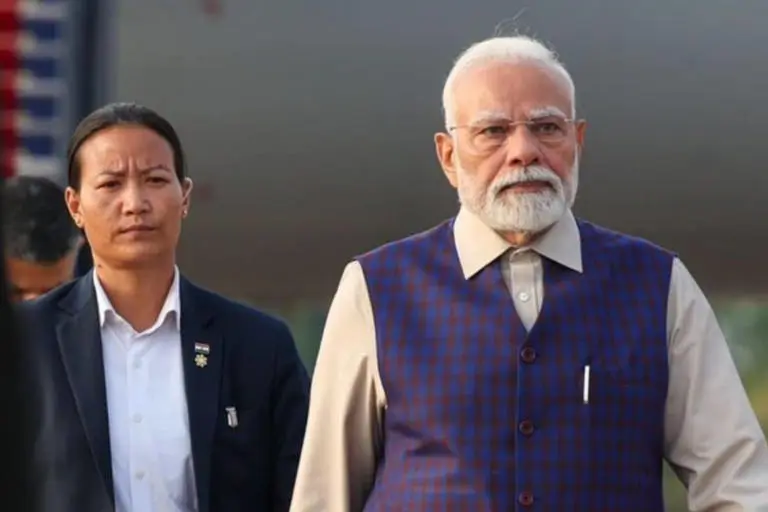
The image of Adaso Kapesa standing vigilantly behind the Prime Minister has gone viral
From Manipur to the Prime Minister’s Inner Circle
In a moment that has captured the nation’s imagination, Inspector Adaso Kapesa has become the first woman officer to serve in Prime Minister Narendra Modi’s elite security detail, the Special Protection Group (SPG). Her presence behind the Prime Minister during his recent visit to the United Kingdom wasn’t just symbolic—it was historic.
Hailing from Kaibi village in Senapati district of Manipur, Adaso’s journey is one of grit, determination, and quiet revolution. Raised in a remote region with limited resources, she nurtured dreams that defied her circumstances. Her path began with the Sashastra Seema Bal (SSB), where she served in the 55th Battalion at Pithoragarh, Uttarakhand. But her ambitions reached further, to the highest echelons of India’s security apparatus.
Her selection into the SPG wasn’t a ceremonial gesture. It followed rigorous commando training designed to test physical endurance, mental acuity, and tactical readiness. Only the most elite officers make the cut, and Adaso’s performance stood out, earning her a place in the team that protects India’s top leadership.
Cracking the Code: What It Takes to Join the SPG
The Special Protection Group is not just another security unit, it’s India’s most exclusive force, established in 1985 after the assassination of Prime Minister Indira Gandhi. Tasked with protecting the Prime Minister and select dignitaries, SPG officers undergo some of the most demanding training regimens in the country.
Adaso’s induction into this male-dominated force marks a seismic shift in how gender is perceived in high-stakes national security roles. Her inclusion is not just a personal milestone—it’s a national statement. It signals that excellence, not gender, defines capability.
To qualify for the SPG, candidates must have an impeccable service record, undergo psychological evaluations, and complete advanced tactical training. Adaso’s journey through these trials is a testament to her discipline and resilience. Her deployment during PM Modi’s UK visit was not just operational—it was strategic, showcasing India’s evolving security culture.
A Symbol of Change and Representation
The image of Adaso Kapesa standing vigilantly behind the Prime Minister has gone viral, sparking admiration and pride across social media. For many, she represents a new era—one where women are not just participants but leaders in India’s defense and law enforcement sectors.
Her story resonates deeply in the Northeast, a region often underrepresented in national narratives. As a Mao-Naga woman from Manipur, Adaso’s rise challenges stereotypes and inspires young women across the country to pursue careers in uniformed services.
Her presence in the SPG also reflects broader efforts to diversify India’s security forces. While the SPG has traditionally been an all-male unit, Adaso’s induction breaks that mold, paving the way for future female officers to follow suit.
Beyond the Uniform: What Her Journey Means for India
Inspector Adaso Kapesa’s story is more than a tale of personal triumph, it’s a blueprint for institutional transformation. Her rise from a remote village to the Prime Minister’s security detail underscores the power of opportunity, training, and belief in one’s potential.
Her journey also highlights the importance of inclusive recruitment and representation in national institutions. As India continues to modernize its defense and law enforcement systems, stories like Adaso’s serve as powerful reminders that talent knows no gender or geography.
In a world where optics matter, her quiet strength and visible presence send a loud message: India’s daughters are ready to stand guard, not just behind its leaders, but beside them.
Also read – Bihar Man Arrested for Threatening PM Modi: Security Agencies on High Alert